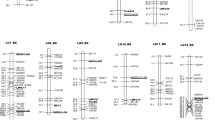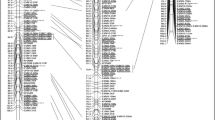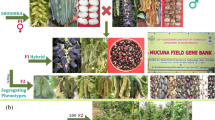Abstract
Quinoa (Chenopodium quinoa Willd.) is an important seed crop for human consumption in the Andean region of South America. It is the primary staple in areas too arid or saline for the major cereal crops. The objective of this project was to build the first genetic linkage map of quinoa. Selection of the mapping population was based on a preliminary genetic similarity analysis of four potential mapping parents. Breeding lines ‘Ku-2’ and ‘0654’, a Chilean lowland type and a Peruvian Altiplano type, respectively, showed a low similarity coefficient of 0.31 and were selected to form an F2 mapping population. The genetic map is based on 80 F2 individuals from this population and consists of 230 amplified length polymorphism (AFLP), 19 simple-sequence repeat (SSR), and six randomly amplified polymorphic DNA markers. The map spans 1,020 cM and contains 35 linkage groups with an average marker density of 4.0 cM per marker. Clustering of AFLP markers was not observed. Additionally, we report the primer sequences and map locations for 19 SSR markers that will be valuable tools for future quinoa genome analysis. This map provides a key starting point for genetic dissection of agronomically important characteristics of quinoa, including seed saponin content, grain yield, maturity, and resistance to disease, frost, and drought. Current efforts are geared towards the generation of more than 200 mapped SSR markers and the development of several recombinant-inbred mapping populations.

Similar content being viewed by others
References
Arumuganathan K, Earle ED (1991) Nuclear DNA content of some important plant species. Plant Mol Biol Rep 9:208–218
Atienza SG, Satovia Z, Petersen KK, Dolstra O, Martin A (2002) Preliminary genetic linkage map of Miscanthus sinensis with RAPD markers. Theor Appl Genet 105:946–952
Barzen E, Mechelke W, Ritter E, Schulte-Kappert E, Salamini F (1995) An extended map of the sugar beet genome containing RFLP and RAPD loci. Theor Appl Genet 89:167–178
Chauhan GS, Eskin NAM, Tkachuk R (1992) Nutrients and anitnutrients in quinoa seed. Cereal Chem 69:85–88
Chauhan GS, Eskin NAM, Tkachuk R (1999) Effect of saponin extraction on quality of quinoa (Chenopodium quinoa Willd.). J Food Sci Technol 36:123–126
Diwan N, McIntosh MS, Bauchan GR (1995) Methods of developing a core collection of annual Medicago species. Theor Appl Genet 90:775–761
Fleming JE, Galwey NW (1995) Quinoa (Chenopodium quinoa). In: Williams JT (ed) Cereals and pseudocereals. Chapman and Hall, London, pp 3–83
Halldén C, Hjerdin A, Rading IM, Säll T, Fridlundh B, Johannisdottir G, Tuvesson S, Åkesson C, Nilsson N-O (1996) A high-density RFLP linkage map of sugar beet. Genome 39:634–645
Hulbert SH, Ilott TW, Legg EJ, Lincoln SE, Lander ES, Michelmore RW (1988) Genetic analysis of the fungus, Bremia lactucae, using restriction fragment length polymorphisms. Genetics 120:947–958
Jeuken M, van Wijk R, Peleman J, Lindhout P (2001) An integrated interspecific AFLP map of lettuce (Lactuca) based on two L. sativa × L. saligna F2 populations. Theor Appl Genet 103:638–647
Keim P, Schupp JM, Travis SE, Clayton K, Zhu T, Shi L, Ferreira A, Webb DM (1997) A high-density soybean genetic map based on AFLP markers. Crop Sci 37:537–543
Lacape JM, Nguyen TB, Thibivilliers S, Bojinov B, Courtois B, Cantrell RG, Burr B, Hau B (2003) A combined RFLP–SSR–AFLP map of tetraploid cotton based on a Gossypium hirsutum × Gossypium barbadense backcross population. Genome 46:612–626
Lashermes P, Combes MC, Prakash NS, Trouslot P, Lorieux M, Charrier A (2001) Genetic linkage map of Coffea canephora: effect of segregation distortion and analysis of recombination rate in male and female meioses. Genome 44:589–596
Lotti C, Salvi S, Pasqualone A, Tuberosa R, Blanco A (2000) Integration of AFLP markers into an RFLP-based map of durum wheat. Plant Breed 119:393–401
Ochoa J, Frinking HD, Jacobs TH (1999) Postulation of virulence groups and resistance factors in the quinoa/downy mildew pathosystem using material from Ecuador. Plant Pathol 48:425–430
Ooijen JW van, Voorrips RE (2001) JoinMap 3.0, software for the calculation of genetic linkage maps. Plant Research International, Wageningen
Patterson AH, Tanksley SD, Sorrells ME (1991) DNA markers in plant improvement. Adv Agron 46:39–90
Pradhan AK, Gupta V, Mukhopadhyay A, Arumugam N, Sodhi YS, Pental D (2003) a high-density linkage map in Brassica juncea (Indian mustard) using AFLP and RFLP markers. Theor Appl Genet 106:607–614
Prado RE, Boero C, Gallard M, Gonzalez JA (2000) Effect of NaCl on germination, growth, and soluble sugar content in Chenopodium quinoa Willd. seeds. Bot Bull Acad Sci 41:27–34
Qi X, Stam P Lindhout P (1998) Use of locus-specific AFLP markers to construct a high-density molecular map in barley. Theor Appl Genet 96:376–384
Rae SJ, Aldam C, Dominguez I, Hoebrechts M, Barnes SR, Edwards KJ (2000) Development and incorporation of microsatellite markers into the linkage map of sugar beet (Beta vulgaris spp.). Theor Appl Genet 100:1240–1248
Risi J, Galwey NW (1984) The Chenopodium grains of the Andes: Inca crops for modern agriculture. Adv Appl Biol 10:145–216
Risi J, Galwey NW (1989) The pattern of genetic diversity in the Andean grain crop quinoa (Chenopodium quinoa Willd.). I. Associations between characteristics. Euphytica 41:147–162
Rohlf FJ (2000) NTSYSpc 2.1: numerical taxonomy and multivariate analysis system. Exeter Software, New York
Ruales J, Nair BM (1993) Content of fat, vitamins and minerals in quinoa (Chenopodium quinoa Willd.) seeds. Food Chem 48:131–136
Ruas PM, Bonifacio A, Ruas CF, Fairbanks DJ, Andersen WR (1999) Genetic relationship among 19 accessions of six species of Chenopodium L., by randomly amplified polymorphic DNA fragments (RAPD). Euphytica 105:25–32
Sambrook J, Fritsch EE, Maniatis T (1989) Molecular cloning: a laboratory manual, 2nd edn. Cold Spring Harbor Laboratory Press, Cold Spring Harbor
Sharma R, Aggarwal RAK, Kumar R, Mohapatra T, Sharma RP (2002) Construction of an RAPD linkage map and localization of QTLs for oleic acid level using recombinant inbreds in mustard (Brassica juncea). Genome 45:467–472
Simmonds NW (1971) The breeding system of Chenopodium quinoa. I. Male sterility. Heredity 27:73–82
Staub JE, Serquen FC, Gupta M (1996) Genetic markers, map construction, and their application in plant breeding. HortScience 31:729–741
Tanksley SD, McCouch SR (1997) Seed bands and molecular maps: unlocking genetic potential from the wild. Science 277:1063–1066
Tapia M, Gandarillas H, Alandia S, Cardozo A, Mujica R, Ortiz R, Otazu J, Rea J, Salas B, Zanabria E (1979) Quinua y kañiwa: Cultivos andinos. CIID-IICA. Bogota
Todd JJ, Vodkin LO (1996) Duplications that suppress and deletions that restore expression from a chalcone synthase multigene family. Plant Cell 8:687–699
Vacher JJ (1998) Responses of two main Andean crops, quinoa (Chenopodium quinoa Willd.) and papa amarga (Solanum juzepezukii Buk.) to drought on the Bolivian Altiplano: significance of local adaption. Agric Ecosyst Environ 68:99–108
Vilanova S, Romero C, Abbott AG, Llácer, Badenes ML (2003) An apricot (Prunus armeniaca L.) F2 progeny linkage map based SSR and AFLP markers, mapping plum pox virus resistance and self-incompatibility traits. Theor Appl Genet 107:239–247
Vos P, Hogers R, Bleeker R, Reijans M, Van de Le T, HornesM, Frijters A, Pot J, Peleman J, Kuiper M, Zabeau M (1995) AFLP: a new technique for DNA fingerprinting. Nucleic Acids Res 23:4407–4414
Vuylsteke M, Mank R, Antonise R, Bastiaans E, Senior ML, Stuber CW, Melchinger AE, Lubbersted T, Xia XC, Stam P, Zabeau M, Kuiper M (1999) Two high-density AFLP linkage maps of Zea mays L.: analysis of distribution of AFLP markers. Theor Appl Genet 99:921–935
Ward SM (2000) Allotetraploid segregation for single-gene morphological characters in quinoa (Chenopodium quinoa Willd.) Euphytica 116:11–16
Ward SM (2001) A recessive allele inhibiting saponin synthesis in two lines of Bolivian quinoa (Chenopodium quinoa Willd.). Heredity 92:83–86
Willams JGK, Kubelik AR, Livak KJ, Rafalski JA, Tingey SV (1990) DNA polymorphism amplified by arbitrary primers are useful as genetic markers. Nucleic Acids Res 18:6531–6535
Wilson HD (1988) Quinoa biosystematics I: domesticated populations. Econ Bot 42:461–477
Wood SG, Lawson LD, Fairbanks DJ, Robison LR, Andersen WR (1993) Seed lipid content and fatty acid composition of three quinoa cultivars. J Food Comp Anal 6:41–44
Yu YG, Saghai Maroof MA, Buss GR, Maughan PJ, Tolin SA (1994) RFLP and microsatellite mapping of a gene for soybean mosaic virus resistance. Phytopathology 84:60–64
Acknowledgements
This research was supported with grants from the McKnight Foundation, the Holmes Family Foundation, and the Erza Taft Benson Agriculture and Food Institute. We thank Robert Jones, Eric Steward, and David Butler of Brigham Young University for their advice and technical assistance with the AFLP analysis.
Author information
Authors and Affiliations
Corresponding author
Additional information
Communicated by D. Hoisington
Rights and permissions
About this article
Cite this article
Maughan, P.J., Bonifacio, A., Jellen, E.N. et al. A genetic linkage map of quinoa (Chenopodium quinoa) based on AFLP, RAPD, and SSR markers. Theor Appl Genet 109, 1188–1195 (2004). https://doi.org/10.1007/s00122-004-1730-9
Received:
Accepted:
Published:
Issue Date:
DOI: https://doi.org/10.1007/s00122-004-1730-9




